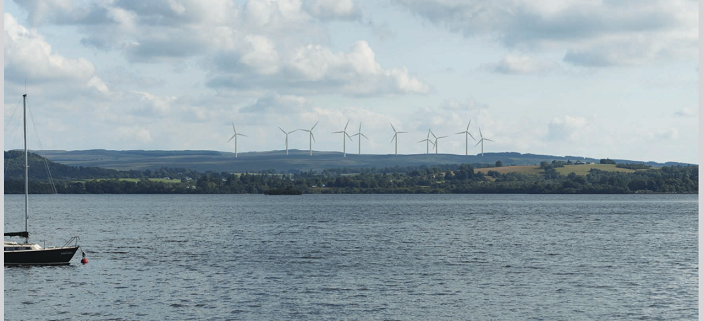
Following the post from Lynne Somerville of the Balloch and Haldane Community Council about the proposed Vale of Leven windfarm in December (see here), I am very pleased to be able to report that Loch Lomond and Trossachs National Park Authority (LLTNPA) staff recommended (see here) to their Planning Committee on Monday that they should lodge a strong objection to the proposal on landscape grounds:
“the adverse effects on the National Park of this proposal would be so significant, that they would not be outweighed by potential benefits. This is due to the overwhelming large size of the proposed wind turbines and the proximity to the National Park. The proposal as presented does not provide sufficient justification as to why this very large scale installation (in terms of turbine size) could not be located elsewhere, in a less sensitive location. The location is not considered appropriate.”
Unfortunately, because the meeting was not webcast, there has been no news release and the minutes of these meetings appear weeks later, it is not clear if board members approved the recommendations staff made in the report. Why the silence?

It is not just the landscape of the National Park that would be affected by the Vale of Leven windfarm but much of the Clyde estuary. The proposal is to erect 10 turbines, 250m high to the tip of blade, on Auchenreoch Muir at the western end of the Kilpatrick Hills, sandwiched in the space between Dumbarton, the Vale of Leven and the National Park. Each turbine could produce up to 7 mega watts of electricity and as a result the decision on the application will be made by the Energy Consents Unit at the Scottish Government which decides all renewable energy developments over 50MW.
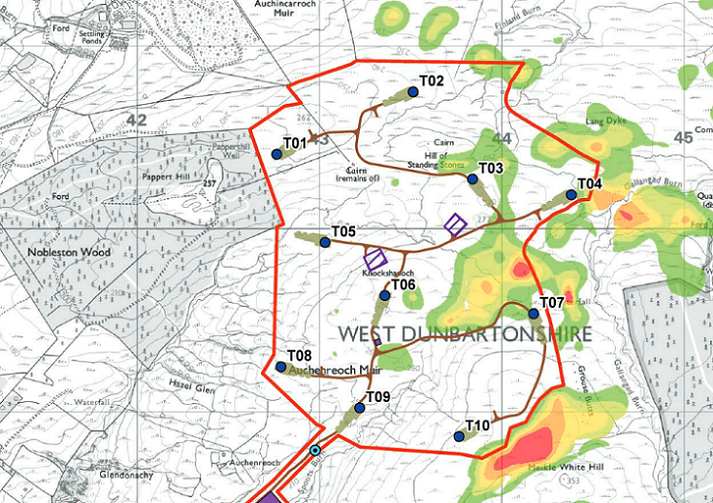
The 250m turbines are enormous (the developer originally proposed 19 but reduced the number and increased the size) and if approved would set a terrible precedent.The LLTNPA was consulted on a previous proposal for the Merkins wind farm in the Kilpatrick Hills in 2012. This was for ten turbines, up to 120m to blade tip height, half the height of the turbines proposed for Auchenreoch Muir. The LLTNPA objected to that proposal due to its visual impact and the application was refused by West Dunbartonshire Council in 2013. So why has this application got so far?
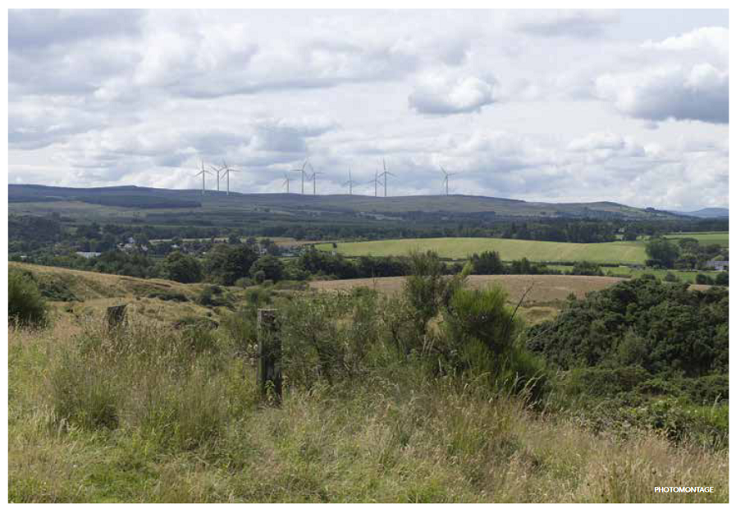
LLTNPA staff clearly explain the unprecedented size of these turbines in their report:
“the tallest operational wind turbine within a 45km radius from the site of the proposed development is currently 147m to blade tip at Calder Water, South Lanarkshire (40km away from the site of the proposed development)…………. The closest operational windfarm to the southern boundary of the National Park, is Corlic Hill/Inverclyde which is 14km southeast and has 8 turbines which are 110m
high to blade tip. This proposal would therefore be a step change in both the proximity of wind turbines to the National Park and the scale of the wind turbines (being more than twice the size of the closest operational wind farm).”

The LLTNPA’s report also highlights specific impacts on local communities within the National Park:
“With regard to the main settlements within the National Park, the LVIA predicts that effects on views would be major and significant from Croftamie (limited locations), Gartocharn (limited locations) and Balloch (limited locations e.g. Viewpoint 5- A811 near Balloch) and major/moderate and significant effects on views from Balmaha (limited locations e.g. Viewpoint 17- Balmaha Harbour- see Appendix 9) and Drymen (limited locations e.g. Viewpoint 14- West Highland Way near Drymen, see Appendix 5);
and outdoor recreation;
“Parts of at least (approximately) 75km of nationally important recreational routes would be subject to significant visual impacts.”
These points are very well made.
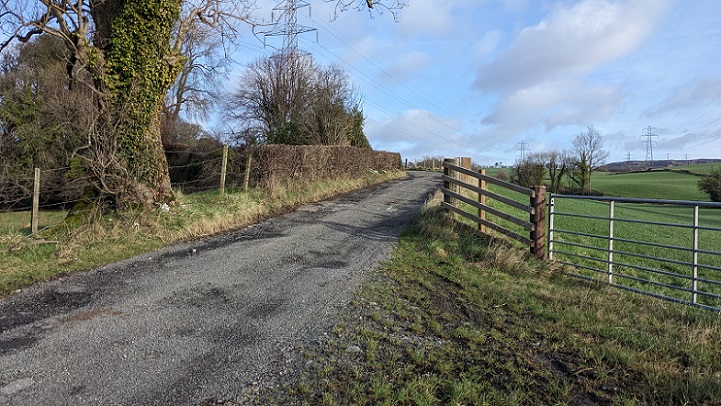
The LLTNPA’s report states that the Landscape Visual Impact Assessment (LVIA) undertaken by the developer generally gives an accurate idea of how the proposed development would look. I agree -the photomontages featured in this post are in my view of high quality and much better in my view than those, for example, submitted with the Flamingo Land Planning Application.
It was good to see, however, that the LLTNPA has also identified a number of shortcomings in the LVIA. For example, the Battery Energy System, borrowpits and access track are omitted from photomontages in which they would have been visible. As significantly the LLTNPA states:
“6.6. In terms of the LVIA assessment findings, most magnitude of change ratings are considered to have been understated which means that the significance of effect ratings are also understated.”
In ordinary language this means the conclusion of the LVIA understates how big a change this windfarm would be for the landscape.

While just outside the National Park boundary, West Dunbartonshire Council has rightly designated the part of the Kilpatricks where it is proposed to erect the turbines as an area of Local Landscape Value. The Kilpatrick hills don’t just form a backdrop to the wonderful views down Loch Lomond, they also form a green buffer along the north side of the Clyde. A strip along their southern side also forms part of the Clyde Green Belt. The wind turbines will also have a significant impact on the landscape of the Clyde estuary and it is welcome that Inverclyde Council has lodged an objection because of this.
From a public interest perspective the Kilpatrick Hills are absolutely the wrong place for a windfarm. This application not only threatens the world-renowned landscape of Loch Lomond but will fundamentally alter the natural backdrop for tens of thousands of people who live, work and travel around the southern shores of Loch Lomond and the Clyde conurbation. In planning jargon, it threatens to completely change the sense of place for a large proportion of the population in Scotland.
Each turbine would be twice the height of the Science Centre Tower in Glasgow, which is a mere 125m or so and not far from the ECU! One wonders how the good people of Edinburgh would have reacted if a building like the London Shard (50m higher) was erected in their midst? It would have provoked national outrage but so far this application has attracted almost zero publicity. One wonders why?
Who is backing the Vale of Leven windfarm?
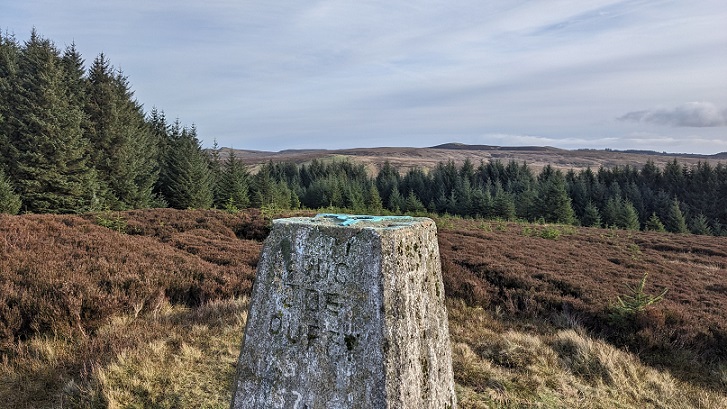
The application has been submitted by a firm called Coriolis in partnership with a construction company, which is part owned by the Irish Government. There are over ten other firms who have undertaken parts of the application, from ecological reports to details of the road construction. The developers are offering “an estimated £14.4 million” over the 40-year operational lifetime of the proposed development – it may not survive that long – or about £350k as a sweetener to local communities.
I was pleased to be invited to speak at a Balloch and Haldane Community Council (BHCC) meeting on 19th February called to discuss the planning application. An online survey conducted by the BHCC had found a majority of the local community against the proposals though many people had little knowledge of what was being proposed. (The Kilmaronock Community Council which covers the area on the south side of Loch Lomond between Balloch and Croftamie has also objected). When asked a large majority of the 40 or so people present present were against the windfarm.
The anger of some of those people towards the power companies, the amounts they are now charging for electricity and the way profits are being extracted out of Scotland was palpable. People are starting to understand how the electricity markets are rigged and controlled for the benefit of shareholders, not the public, and the point was made about why can’t we have a Scottish Government owned construction company rather than an Irish one pushing developments such as these? People also saw the sweetener for what it is. (£350k a year for local communities is significantly less than the current salary of the Chief Executive of the Post Officer, Mr Read, whose pay for 2022/23 totalled £573,000 but who now, it has been revealed, thinks he was worth twice that).
While the developers have offered local communities a 15% stake in the windfarm (and therefore the profits) how they would raise this money has not been explained. 15%, however, leaves the developers tin control of what happens and with the vast majority of the profits. With so little on offer to local communities from these developments, we would be better insisting they were all built out of sight and out at sea.
At present less than 30 public comments have been lodged in response to the application on the Energy Consents Unit website. Those against outnumber those for by 3 to 1, 21 to 7 and include a letter from Jackie Baillie, MSP, lodging concerns on behalf of her local constituents.
Sadly among those supporting the application are the Friends of Loch Lomond and Trossachs (FOLLAT). I knew they had shifted their position from outright opposition to windfarms that might impact on the landscape of the National Park to something more nuanced so, for example, they would no longer object to windfarms that might be visible in the far distance.
But supporting a windfarm that will be highly visible across the whole of the southern half of Loch Lomond and its surrounding hills? In my view, this is contrary to the very reason FOLLAT was first created, to stop the construction of a hydro scheme at Robroyston on the north side of Ben Lomond and to protect the very special landscape of the area.
The LLTNPA – acting like a National Park should
Regular readers will have noted that instead of criticising the arguments the LLTNPA have made in their report, as I usually do, I have drawn on them for this post. For anyone concerned about the application who wants to identify “material” reasons – i.e those that count under planning law – for objecting to the development on landscape grounds, the best thing to do is read the LLTNPA report. I cannot commend it highly enough. I have not tried to repeat all those arguments here but suffice to say the frontline staff who wrote this report should be congratulated. Let’s hope they are allowed to apply similar principles and rigour when it comes to the Flamingo Land application!
It is worth noting that LLTNPA staff in their report state they have been working closely with landscape staff from NatureScot who have apparently reaches similar conclusions. NatureScot’s comments on the application have yet to be submitted so whether NatureScot’s staff are allowed to articulate the arguments in the way the LLTNPA have done remains to be seen.
How to comment on the Vale of Leven planning application
The planning portal used by the Energy Consents Unit of the Scottish Government is in my view poor and difficult to use. It appears different to the Idox system used by Local Authorities and our National Parks but maybe it has just been configured to be less user-friendly? There is no online map search facility and unless you know the name of a development or the developer you won’t find anything. You can search for recent cases but this only shows you applications that have been consented or refused, not those that are in the pipeline. This means there is no way, for example, for the people of the Glasgow conurbation to find out what out what other windfarms might be being planned for the countryside round about.
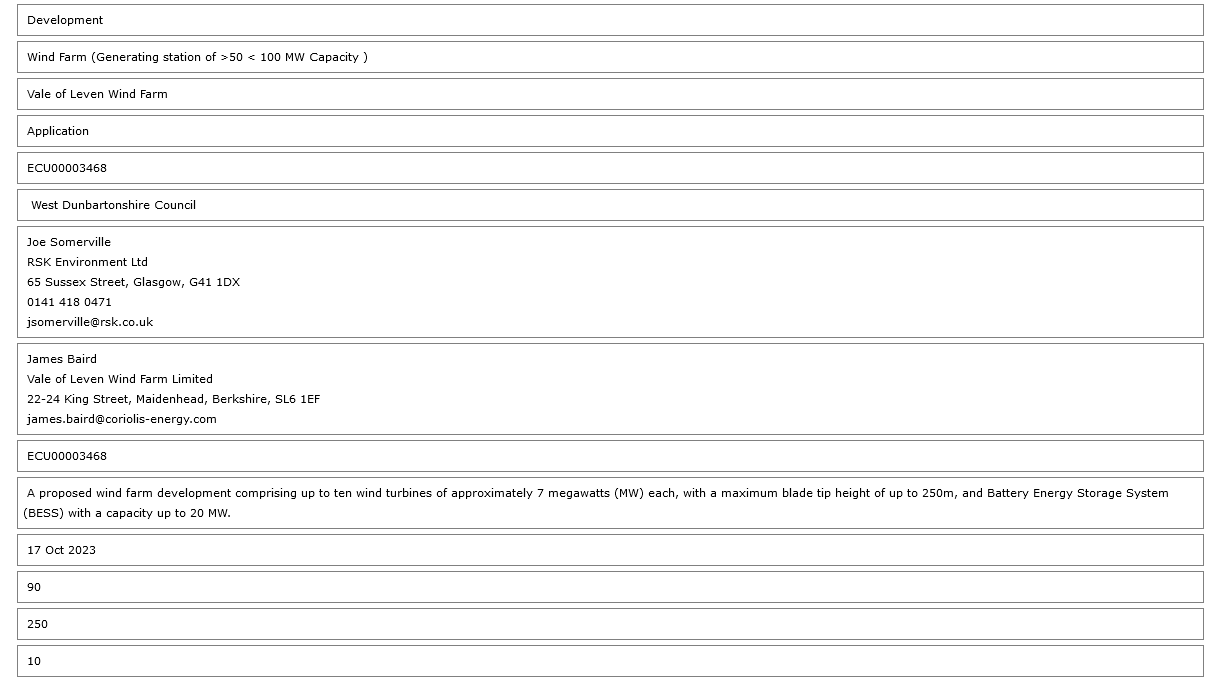
Unlike the local authority system the ECU system does not provide a public record of important dates, such as deadlines for decisions and there is not even a closing date for comments. I understand that the deadline was to be today but that West Dunbartonshire Council has asked and been granted an extension until 1st June. If WDC have been granted an extension that should also be extended to the general public.
If you wish to submit a comment whether today or later you can try and do so here – click the representation button. You will need to register first, however, if you have not already done so, through a clunkier process and more time consuming process than that used by local authorities.

The way the documents associated with an application are listed also makes it very difficult to find out what is proposed or what is being said. The information on the Developer’s website is far more accessible https://valeoflevenwindfarm.com/. It is almost as though the Scottish Government doesn’t want the public to know what is being proposed. Every reason to make your views known!

There is no longer any justification for the erection of these giant wind turbines on land in Scotland. The stupidity of this and other proposals was explained by Vicky Allan in the Herald on 10 Feb when she investigated the log jam for grid connections from on and offshore wind farm developers: “The total transmission queue currently stands at 420GW and this alone represents over 7 times more capacity than the current peak demand in Great Britain (58GW) and over 4 times more capacity than the potential peak demand in GB in 2050 (98GW)” In other words the whole of our future wind farm energy needs can be met from offshore wind farms. Onshore we would be far better served by small scale developments, with turbines no taller than 50 metres to the vertical blade tip, to meet the needs of farmers, crofters and local communities. Giant turbines are still being proposed on land to primarily to satisfy the commercial greed of developers in distant places not to meet local need. We need to stop this desecration of the natural beauty of Scotland by ensuring no politician in future is elected to the UK or Scottish Parliaments if they support giant turbines spreading across the land of Scotland.